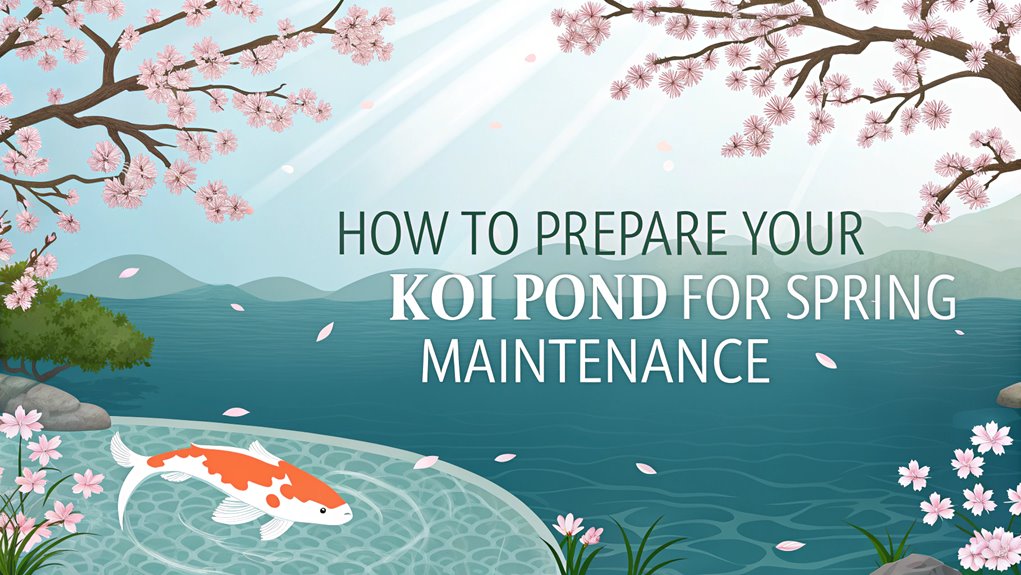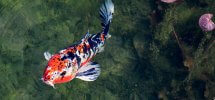To prepare your koi pond for spring, first monitor water temperature and quality, targeting 50–55°F. Carefully relocate koi to a shaded tank, and drain the pond to remove debris and clean surfaces. Inspect and repair equipment such as pumps and filters. Refill the pond with fresh water and treat it to remove chlorine. Reintroduce koi gradually, begin cautious feeding, and enhance the environment with plants. Unlocking these tips will deepen your insight into effective pond management.
Key Facts Summarized
- Monitor water temperature, aiming for 50–55°F, and regularly test key water quality parameters like pH, ammonia, and nitrate levels.
- Relocate koi to a shaded holding tank and carefully drain the pond to preserve beneficial bacteria.
- Power wash pond surfaces and use a vacuum to remove debris and accumulated sludge from the pond bottom.
- Inspect and clean pond equipment, including pumps, skimmers, and filters, to ensure efficient water circulation and filtration.
- Refill the pond with fresh water, add a detoxifier, and test water quality to ensure a healthy environment for koi.
Monitor Water Temperature and Quality
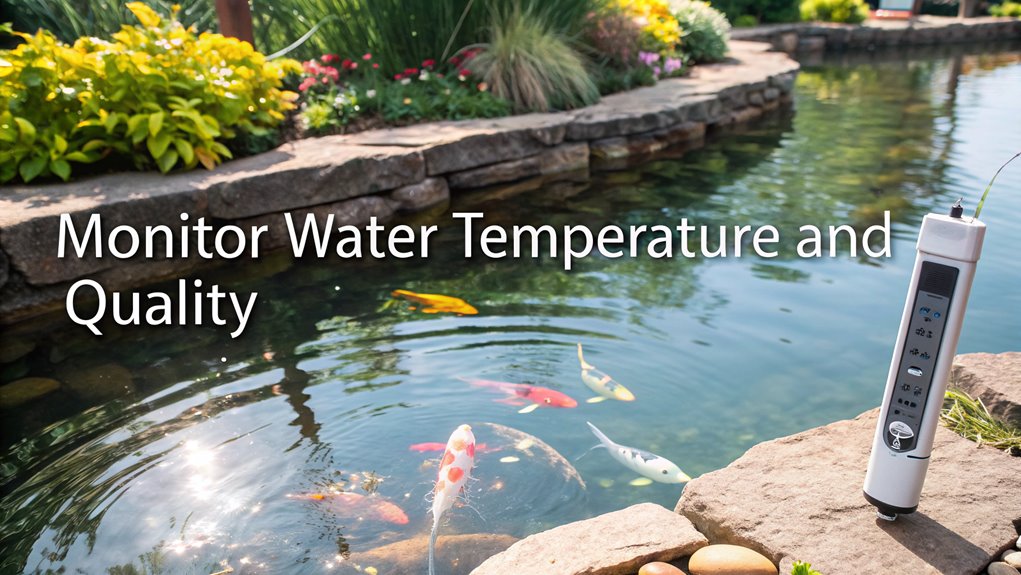
As you prepare your koi pond for spring, it’s crucial to monitor both water temperature and quality to ensure your Koi thrive.
Use a floating pond thermometer to track the water temperature, targeting a stable range of 50–55°F. This precision is vital since Koi, being cold-blooded, rely on optimal temperatures for health and behavior.
Regularly test water quality parameters like pH, ammonia, nitrate, nitrite, and alkalinity. Aim for a pH level between 7.3 and 7.7 to support fish health and effective filtration system performance.
Conduct tests before and after maintenance activities to ensure conditions remain balanced. Monitoring these factors helps maintain beneficial bacteria levels, promoting a thriving aquatic environment for your Koi. Additionally, ensure that ammonia levels remain at 0 mg/liter to prevent toxicity and stress in your fish.
Relocate Koi and Drain the Pond
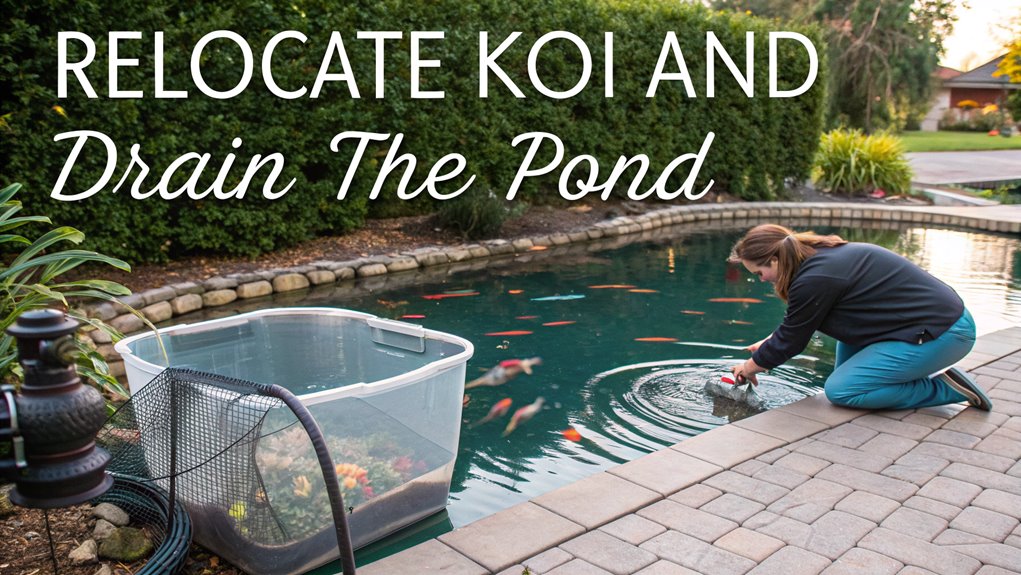
After ensuring optimal water conditions, the next step in preparing your koi pond for spring involves relocating the koi and draining the pond.
Begin by setting up a holding tank filled with pond water. This tank should have adequate aeration and be placed in a shaded area to reduce stress.
Carefully drain the pond to about one foot of water, preserving beneficial bacteria levels. Use a fish net to gently catch each koi, transferring them to the holding tank. Secure netting over the tank to prevent any escape attempts.
It’s crucial to monitor behavior to ensure minimal stress during this process. Once the pond is drained, inspect it for necessary maintenance before reintroducing the koi, ensuring water quality and temperature are suitable. Additionally, remember to perform a 10% water change to maintain water quality before filling the pond back up.
Remove Debris and Clean the Pond
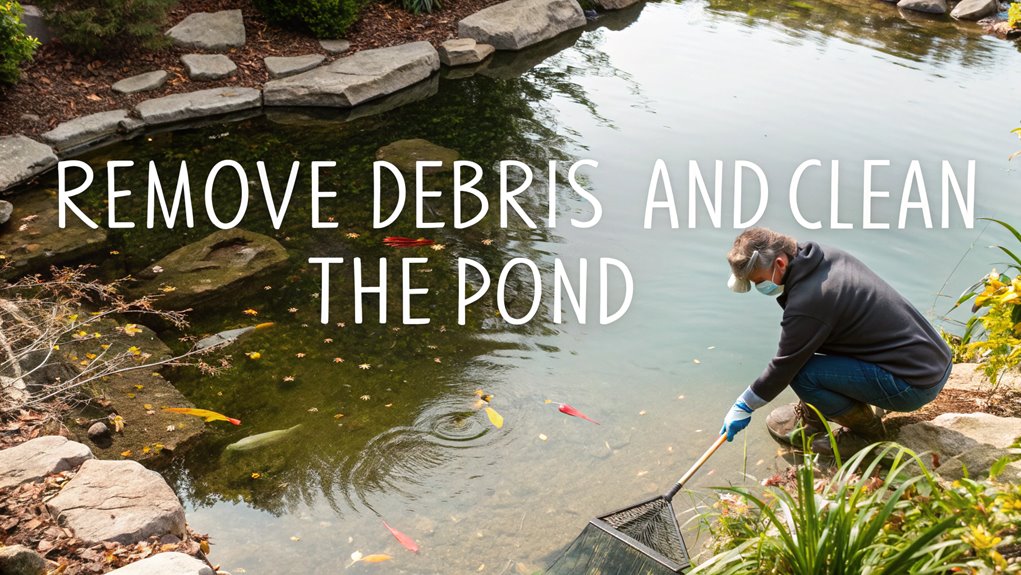
Before diving into the cleaning of your koi pond, ensure smooth access by draining the water level down to about six inches.
Start by using a fish net to gently relocate your koi to a shaded holding tank filled with pond water.
With the pond nearly empty, power wash surfaces, rocks, and edges to remove debris and stubborn algae, promoting optimal aquatic health.
Next, focus on the pond’s bottom; use a vacuum or skimmer to extract accumulated sludge, preventing nutrient overload and subsequent algae growth.
Rinse all filter media and skimmer components to maintain efficient water circulation.
This thorough cleaning and maintenance routine, paired with regular water changes, will keep your pond pristine and ready for a vibrant spring. Additionally, regular cleaning helps maintain water quality parameters, which is essential for preventing algae growth.
Inspect and Repair Pond Equipment
When preparing your koi pond for spring, inspecting and repairing pond equipment is essential to ensure a thriving aquatic environment. Begin with the pond pump; make sure it’s clean and functioning, as it’s vital for water circulation. Next, inspect the skimmer for debris and clean it to maintain optimal water quality. Check for leaks in the pond liner or fixtures—quick repairs prevent nutrient overload. It is also crucial to regularly check and clean the filtration system to maintain efficiency.
| Task | Action | Purpose |
|---|---|---|
| Pond Pump | Clean and inspect | Ensure water flow |
| Skimmer | Remove debris | Maintain water quality |
| Equipment Check | Inspect and repair | Healthy environment |
Test filters and UV clarifiers, replacing worn parts to keep your pond system efficient. With maintenance done, your koi’s habitat remains pristine and healthy.
Refill the Pond and Treat Water
With the pond equipment now in optimal condition, it’s time to focus on refilling the pond and treating the water to create a hospitable environment for your koi.
Begin by refilling the spring pond with fresh water, ensuring the temperature is around 65°F to support koi health. As you refill, add a detoxifier like Stress Reducer Plus to eliminate chlorine and detoxify heavy metals.
Monitor the water levels closely to maintain stability, avoiding rapid temperature changes that could stress your koi.
Once filled, test the pond’s water quality, checking pH levels to keep them between 7.3-7.7. Assess other parameters such as ammonia and nitrite levels to guarantee safety. This meticulous approach ensures a thriving environment for your koi, especially since preventative treatments are recommended to protect them during this vulnerable period.
Reintroduce Koi to the Pond
As you prepare to reintroduce your koi to the pond, ensuring a stable water temperature around 65°F is crucial for easing their transition.
Begin by performing detailed water quality tests; check pH, ammonia, and nitrite levels to ensure they’re within safe limits for Koi Fish, ideally with a pH of 7.3 to 7.7.
Acclimate koi by floating their holding tank in the pond for 20-30 minutes, allowing them to adjust gradually to the new environment.
After confirming optimal conditions, gently release them while closely monitoring their behavior for any health issues.
Maintain vigilant pond maintenance post-release by observing koi activity and adjusting feeding schedules accordingly to prevent stress and promote well-being.
This meticulous approach ensures a seamless transition for your koi.
Begin Gradual Feeding
Feeding your koi gradually becomes essential as water temperatures climb to 50°F to 55°F, signaling an improvement in their digestion.
Begin feeding koi with soft, digestible foods like Manda Fu Koi Food, which boasts a 98.2% digestion rate. At these temperatures, offer food once every few days, then transition to daily feeding when temperatures exceed 55°F.
Monitor food amounts carefully to prevent overfeeding, which can degrade water quality by creating excess waste and nutrient overload.
Tailor your feeding approach to the changing water temperatures and observe koi behavior closely to maintain optimal health.
Enhance Pond Environment With Plants and Bacteria
To create a thriving and balanced koi pond environment, consider enhancing it with the strategic introduction of plants and beneficial bacteria. Add aquatic plants like waterlilies and floaters to boost oxygen levels and outcompete algae for nutrients. Regularly apply beneficial bacteria treatments, such as Niigata Water BioFiltration Bacteria, especially during spring pond maintenance. This supports waste removal and a healthy nitrogen cycle, crucial for koi health. Use Cold Water Beneficial Bacteria below 50°F for effective algae competition and optimal water quality. Diverse plant species not only beautify but also enhance biodiversity, improving the pond’s resilience.
| Enhancement Method | Benefits |
|---|---|
| Aquatic Plants | Increase oxygen, compete with algae |
| Beneficial Bacteria | Waste removal, establish nitrogen cycle |
| Cold Water Bacteria | Algae competition below 50°F, water quality |
| Plant Diversity | Beautifies, enhances biodiversity |
Frequently Asked Questions
How to Prepare a Koi Pond for Spring?
Start by testing water parameters: pH, ammonia, and temperature. Drain the pond partially, relocate koi safely. Power wash surfaces, clean the filter, refill with treated water. Reintroduce koi gradually, ensuring their environment is pristine and balanced.
How Do You Keep a Spring Fed Pond Clean?
Imagine balancing a delicate aquatic ballet. You’ll need to regularly skim debris, introduce nutrient-hungry plants, and apply beneficial bacteria. Monitor water parameters like pH and ammonia, ensuring they’re optimal, fostering a clean, vibrant ecosystem.
Can I Put Epsom Salt in My Koi Pond?
Yes, you can add Epsom salt to your koi pond. Dissolve it first in a separate container and use around 1 tablespoon per 100 gallons. Monitor koi closely for any stress or adverse reactions afterwards.
What Is the Best Thing to Put in the Bottom of a Koi Pond?
Think of the substrate as the pond’s foundation of life. Use smooth, rounded gravel to symbolize harmony. Add Niigata Water Bio Balls to invigorate the nitrogen cycle. Avoid sharp rocks to protect koi. Maintain cleanliness diligently.
Conclusion
As spring whispers its arrival, your koi pond transforms into a serene oasis, reflecting meticulous care and vibrant life. With water now a crystal-clear canvas, you’ve ensured a harmonious homecoming for your koi. The gentle hum of repaired equipment and the delicate dance of plants paint a picture of renewal. Every step, like a brushstroke, enhances this aquatic masterpiece. Remember, a thriving pond is not just maintenance—it’s an artful blend of nature’s palette and your dedicated stewardship.
